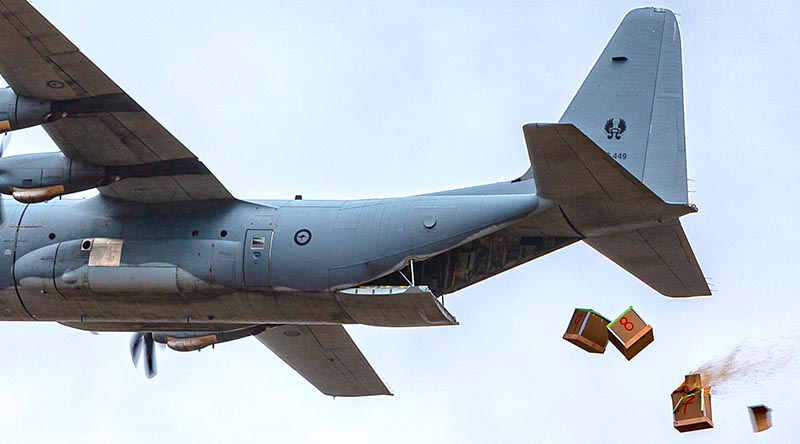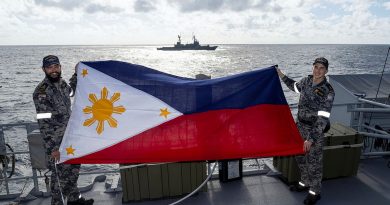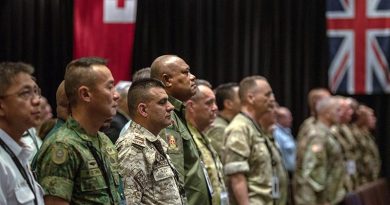RAAF testing new fodder-drop concept

Cattle stranded by floodwaters may soon receive help from above, thanks to airdrop trials at RAAF Base Richmond.
CAPTION: Bundles of livestock fodder fall from a No. 37 Squadron C-130J Hercules during an Air Mobility Training and Development Unit trial at Londonderry, NSW. Photo by Corporal David Said.
Air Mobility Training and Development Unit (AMTDU) is clearing a new method of delivering fodder using C-130 Hercules and C-27J Spartan transport aircraft.
It’s a safer method of performing a role last conducted by [the Royal Australian*] Air Force in the 1980s and ’90s, according to Commanding Officer of AMTDU Wing Commander Cameron Clark.
“The new method involves constructing a frangible box around the fodder, reducing the risk from foreign object debris damage to the aircraft,” Wing Commander Clark said.
“Constructing this load needed easily acquired materials that would not injure animals if ingested and the fodder needed to be disseminated on the ground without humans.”
The task of finding a new fodder delivery method was handed down to AMTDU after the 2019-2020 high-risk weather season.
When the role was historically performed by RAAF aircraft, the fodder bundles were left uncovered inside the cargo bay and pushed off the ramp over the drop zone.
“Because the old method involved uncovered bundles of fodder, it presented a hazard with dust and fibre accumulating inside the aircraft following the drop,” Wing Commander Clark said.
“The debris would accumulate everywhere – under floors and inside avionics boxes – and our maintenance teams were still finding it months after the drops.”
Each fodder bundle weighs about 160 kilograms.
To reduce the debris risk, AMTDU wrapped the fodder in available cardboard and wooden skid boards, which are commonly used in the creation of airdrop loads.
Initial trials were conducted in late August at the nearby Londonderry Drop Zone in Sydney’s north-west.
This load could be constructed quickly, but it would break apart almost immediately it hit the airstream at more than 150km/h.
“This initial version was suitable for a limited clearance, but it was starting to come apart too close to the aircraft,” Wing Commander Clark said.
“The decision was made to build a ‘version 1.1’ load using the lessons learned from that trial to expand the clearance envelope.”
Warrant Officer Class 2 Joe Campbell, a Project Officer with AMTDU, said cattle needed to be able to eat the fodder without people being at the drop zone to unpack the load.
“The solution to the problem is either to have the fodder fall apart in the sky or to break upon impact,” Warrant Officer Campbell said.
“We chose to break it on the ground, as history has proven the hay flies back into the aircraft if it is designed to fall apart in the air.”
All loads carried on Defence aircraft need to be designed so they can withstand violent or sudden movements in flight while remaining restrained to the cargo floor.
Normal airdrop loads would use parachutes, however, they were not employed on fodder drops because of the risk of cattle either ingesting or becoming caught in the cordage.
The version 1.1 box was built as a cube, allowing it to tumble more evenly through the air.
“The solution uses no cordage, as cordage would be hard to consume by the cattle,” Warrant Officer Campbell said.
“The straps that normally hold the bales together are also removed and we make the load strong enough to survive the required flight regimes, including freefall.
“We were able to use in-service cardboard boxes reinforced with edge protectors.”
The ADF has been involved in assisting the community with delivery of fodder by land and using helicopters.
Commander of Air Mobility Group Air Commodore Carl Newman said the fodder drop capability provided Air Force with another means of supporting whole-of-government disaster-relief operations.
“The fodder drop does require sufficient clear land for us to mark a drop zone so that we didn’t harm the livestock we’re there to help,” Air Commodore Newman said.
“However, this role allows us to conduct fodder drops when cattle had no other means of being reached in a timely manner, either by land or air resupply.”
Air Force has demonstrated other methods of how it can support stranded cattle and other people in need in recent disaster relief operations.
During the 2019 floods in central Queensland, it delivered fuel bladders to regional airports so helicopters could carry fodder to stranded cattle.
*EDITOR’S NOTE: It seems our accusation that RAAF is deliberately trying to drop Royal Australian from its name may not be false after all.
.
.
.
.
.
.

.
.





